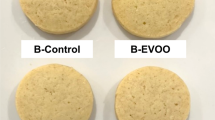Abstract
A new vegetable, and trans-fatty acid-free, fat replacer consisting of a sunflower oil–water–cellulose ether emulsion was employed to replace 100 % of the shortening in a short dough biscuit recipe, and the dough and biscuit texture properties were evaluated. In comparison to the shortening dough, the cellulose emulsion dough was significantly (p < 0.05) softer and more elastic. However, the cellulose emulsion biscuits had higher spreadability, implying that the increase in dough elasticity was not affecting this property, probably because of the decrease in dough hardness. Although the cellulose emulsion biscuits contained 33 % total less fat than the shortening biscuits, their instrumental texture properties were very similar, implying that the cellulose emulsion avoids the increase in hardness associated with fat reduction. This was associated with the thermal gelation ability of the cellulose ethers, which develops during baking. The overall consumer acceptance was significantly (p < 0.05) higher in the shortening biscuits, but their scores were very similar to those of the cellulose emulsion biscuits (maximum difference 1.1/9 points).





Similar content being viewed by others
References
Baltsavias, A., Jurgens, A., & Van Vliet, T. (1999). Fracture properties of short-dough biscuits: effect of composition. Journal of Cereal Science, 29(3), 235–244.
Chevallier, S., Colonna, P., Buléon, A., & Della Valle, G. (2000). Physicochemical behaviors of sugars, lipids, and gluten in short dough and biscuit. Journal of Agricultural and Food Chemistry, 48(4), 1322–1326.
Conforti, F. D., Charles, S. A., & Duncan, S. E. (1996). Sensory evaluation and consumer acceptance of carbohydrate-based fat replacers in biscuits. Journal of Consumer Studies and Home Economics, 20(3), 285–296.
Drewnowski, A. (1992). Sensory properties of fats and fat replacements. Nutrition Reviews, 50(4 II), 17–20.
Drewnowski, A., Nordensten, K., & Dwyer, J. (1998). Replacing sugar and fat in cookies: impact on product quality and preference. Food Quality and Preference, 9(1–2), 13–20.
Dunn, P. D., Burton, J. D., Xu, X., & Atkins, A. G. (2007). Paths swept out by initially slack flexible wires when cutting soft solids; when passing through a very viscous medium; and during regelation. Proceedings of the Royal Society A: Mathematical, Physical and Engineering Sciences, 463(2077), 1–20.
Forker, A., Zahn S., & Rohm H. (2011). A combination of fat replacers enables the production of fat-reduced shortdough biscuits with high-sensory quality. Food and Bioprocess Technology. doi:10.1007/s11947-011-0536-4.
Goh, S., Charalambides, M., & Williams, J. (2005). On the mechanics of wire cutting of cheese. Engineering Fracture Mechanics, 72(6), 931–946.
Grigelmo-Miguel, N., Carreras-Boladeras, E., & Martín-Belloso, O. (2001). Influence of the addition of peach dietary fiber in composition, physical properties and acceptability of reduced-fat muffins. Food Science and Technology International, 7(5), 425–431.
Hadnadev, M., Dokić, L., Hadnadev, T. D., Pajin, B., & Krstonošić, V. (2011). The impact of maltodextrin-based fat mimetics on rheological and textural characteristics of edible vegetable fat. Journal of Texture Studies, 42(5), 404–411.
Inglett, G., Warner, K., & Newman, R. (1994). Sensory and nutritional evaluations of oatrim. Cereal Foods World, 39(10), 755.
Kobayashi, K., Huang, C.-I., & Lodge, T. P. (1999). Thermoreversible gelation of aqueous methylcellulose solutions. Macromolecules, 32(21), 7070–7077.
Labuza, T. P., & Dugan, L. (1971). Kinetics of lipid oxidation in foods. Critical Reviews in Food Science and Nutrition, 2(3), 355–405.
Laguna, L., Salvador, A., Sanz, T., & Fiszman, S. M. (2011). Performance of a resistant starch rich ingredient in the baking and eating quality of short-dough biscuits. LWT- Food Science and Technology, 44(3), 737–746.
Leland, J. V. (1997). Flavor interactions: the greater whole. Food Technology, 51(1), 75–80.
Manley, D. (2000). Technology of biscuits, crackers and cookies (3rd ed.). Cambridge: Woodhead.
Micha, R., & Mozaffarian, D. (2010). Saturated fat and cardiometabolic risk factors, coronary heart disease, stroke, and diabetes: a fresh look at the evidence. Lipids, 45(10), 893–905.
Pareyt, B., & Delcour, J. A. (2008). The role of wheat flour constituents, sugar, and fat in low moisture cereal based products: a review on sugar-snap cookies. Critical Reviews in Food Science and Nutrition, 48(9), 824–839.
Pareyt, B., Wilderjans, E., Goesaert, H., Brijs, K., & Delcour, J. A. (2008). The role of gluten in a sugar-snap cookie system: a model approach based on gluten–starch blends. Journal of Cereal Science, 48(3), 863–869.
Piteira, M. F., Maia, J. M., Raymundo, A., & Sousa, I. (2006). Extensional flow behaviour of natural fibre-filled dough and its relationship with structure and properties. Journal of Non-Newtonian Fluid Mechanics, 137(1–3), 72–80.
Sabanis, D., & Tzia, C. (2009). Effect of rice, corn and soy flour addition on characteristics of bread produced from different wheat cultivars. Food and Bioprocess Technology, 2(1), 68–79.
Sanz, T., Fernández, M. A., Salvador, A., Muñoz, J., & Fiszman, S. M. (2005). Thermogelation properties of methylcellulose (MC) and their effect on a batter formula. Food Hydrocolloids, 19(1), 141–147.
Sarkar, N. (1979). Thermal gelation properties of methyl and hydroxypropyl methylcellulose. Journal of Applied Polymer Science, 24(4), 1073–1087.
Seker, I. T., Ozboy-Ozbas, O., Gokbulut, I., Ozturk, S., & Koksel, H. (2010). Utilization of apricot kernel flour as fat replacer in cookies. Journal of Food Processing and Preservation, 34(1), 15–26.
Sudha, M. L., Srivastava, A. K., Vetrimani, R., & Leelavathi, K. (2007). Fat replacement in soft dough biscuits: its implications on dough rheology and biscuit quality. Journal of Food Engineering, 80(3), 922–930.
Zoulias, E., Oreopoulou, V., & Tzia, C. (2000). Effect of fat mimetics on physical, textural and sensory properties of cookies. International Journal of Food Properties, 3(3), 385–397.
Zoulias, E. I., Oreopoulou, V., & Kounalaki, E. (2002). Effect of fat and sugar replacement on cookie properties. Journal of the Science of Food and Agriculture, 82(14), 1637–1644.
Acknowledgments
The authors are grateful to The Dow Chemical Co. for kindly supplying the cellulose ethers and to Mary Georgina Hardinge for assistance with the English language of the manuscript.
Author information
Authors and Affiliations
Corresponding author
Rights and permissions
About this article
Cite this article
Tarancón, P., Salvador, A. & Sanz, T. Sunflower Oil–Water–Cellulose Ether Emulsions as Trans-Fatty Acid-Free Fat Replacers in Biscuits: Texture and Acceptability Study. Food Bioprocess Technol 6, 2389–2398 (2013). https://doi.org/10.1007/s11947-012-0878-6
Received:
Accepted:
Published:
Issue Date:
DOI: https://doi.org/10.1007/s11947-012-0878-6




